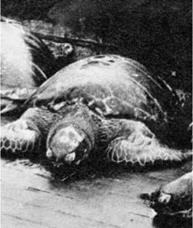SOYUZ FLIES AGAIN
The managers of the Zond programme followed closely the requalification of the Soyuz programme, grounded since Vladimir Komarov’s fatal mission in April 1967.
|
Zond 5 in the Indian Ocean |
|
Zond 5’s turtles |
A successful flight of Soyuz would give much confidence that the closely related L-1 Zond could be flown out to the moon and back, manned, that autumn. Cosmos 238 flew a four-day profile that August to pave the way for the first manned Soyuz flight for 18 months. Selected for the mission was 47-year-old wartime combat veteran and test pilot Georgi Beregovoi.
Soyuz was ready to go on 25th October, a month after the return of Zond. So close were the American and Soviet programmes to one other at this stage that Soyuz 2 flew only three days after the end of the first test of America’s new Apollo. The Americans had returned to space with Apollo 7, which orbited the Earth from the 11th to the 22nd of October, crewed by veteran Walter Schirra and novices Walter Cunningham and Don Eisele. It was technically such a perfect mission that, for the Americans, nothing now stood in the way of sending Apollo 8 around the moon. NASA’s new administrator Tom Paine confirmed that Apollo 8 would fly to the moon, would make ten lunar orbits and gave the date for launch as 21st December. But he could not be certain whether his team of Frank Borman, Jim Lovell and Bill Anders would be the first to report back from there.
Soyuz 2 was launched first, on 25th October, unmanned. Soyuz 3, with Georgi Beregovoi on board, roared off the pad the next day into a misty drizzling midday sky. Half an hour later he was close to the target, Soyuz 2. Then things began to go wrong. Several docking attempts were made but, it later transpired, the craft had been aligned the wrong way up. Excessive fuel was used. Sensors failed on both spacecraft. The planned docking was abandoned, Soyuz 2 was brought down and after four days Georgi Beregovoi came home. Thick, early snow lay on the ground and the temperature was — 12°C. Helicopters were in the air looking for him and villagers were outside their houses on the lookout too. Strong winds blew the capsule sideways into a snowdrift and the impact was so gentle that Georgi Beregovoi barely noticed it. Villagers waded through the snowdrifts and, amidst flecks of snow, the grinning flier had his picture taken before being whisked away for debriefing. But he had returned alive from the first successful manned orbit test of the Soyuz. Now Zond had flown automatically around the moon and a manned spaceship like Zond had circled the Earth for four days, both returning safely. A manned circumlunar mission could not be far away.












